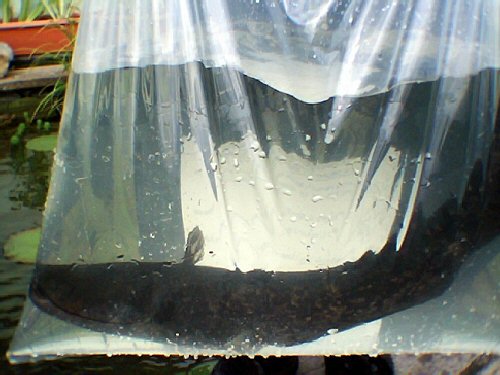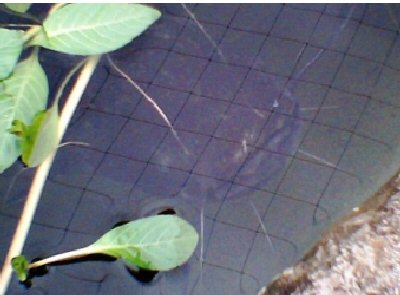SCOTCAT.COM
your internet guide to all things catfish
| A Pond for Purdey |
by Daphne Layley |
Purdey en route to larger quarters
It has two levels of planting ledges around it, one at 10 inches deep, for the marginal plants and another, at 24 inches deep, for the water lilies. It is built with re-inforced concrete, with a butyl liner as well – a ‘belt & braces’ approach, which seemed sensible. Over the years, it has housed many goldfish and Koi carp, these were mainly to placate Graham, who thought they were “attractive” – I had to promise him something as he dug that huge hole, carried all those bags of cement and mixed all that concrete. However, I had always nurtured a secret dream of having a large, coldwater catfish in it, instead of all those little “pretty” things, and finally it’s beginning to look hopeful. The fish have all been re-homed, apart from a select few ‘old friends’ who have been re-located to smaller quarters. The pond has been completely emptied, including about 10 bucketfuls of especially fragrant black sludge from the deep end. All surfaces have been scrubbed, pressure-washed and rinsed and the pond has been refilled, a process which took all day and all night. The marginal plants, twenty different species, have all been split up and replanted in new containers with fresh compost. Over the years, I’ve experimented with many types of liners for planting baskets - old net curtains, hessian squares, foam squares, woven plastic etc. etc. But none of these have really proved satisfactory. The new breed of planting baskets, with fine mesh, are not supposed to need liners, but believe me, they do. Recently, I’ve been trying something which I think is the best so far – black rot-proof landscape fabric from any garden centre. It’s pliable, breathable, easy to cut to size, non-toxic, and it allows water through, but not soil. I tried it first on our wildlife pond, about two years ago, and so far, so good. The water lilies, ten varieties, have all had the same treatment and it’s all looking pretty good. The down side is that I couldn’t bring myself to throw away all the extra baby plants, so they all got potted-up as well, in smaller pots, and they are now all spread around the garden, plunged into all sorts of tubs and troughs and anything else that holds water. What this means is that I now have doubles, and in some cases, trebles, of every plant and lily – back to the ‘belt & braces’! Filtration is via 4 chamber Vortec filter, powered by an Oase Aquamax 16000 pump. Half of the flow goes through the filter; the other half is diverted down the waterfall, which is built in to the rockery behind the pond. The construction of the rockery was the obvious solution regarding what to do with all the soil that came out of the original dig. It’s July and everything is now ready. The plants are growing – the filter is mature – all that is needed now is for the weather to warm up, so that the pond temperature reaches about 76° F. Hopefully, we’ll have some sort of summer this year, but it’s not warm enough yet. When it does, it will be time for the “big move”. Purdey, my coldwater catfish, has been living in a 2 metre tank in the fishroom. She is a juvenile European Wels catfish, Silurus glanis, and she came to me via someone who didn’t want to see her destroyed. For those who don’t know, the Wels catfish is now a prohibited species in this country, unless you hold a licence to keep them. Fortunately for her, I am a licence holder and the rest, as they say, is history. She was named (quite uncharacteristically and rather mysteriously) by Graham. Whether he had fond memories of Joanna Lumley playing the part of Purdey in the 1960’s television series “The Avengers”, or whether he had fond memories of an old girlfriend of that name, I do not know, and he is not saying.....Ironically, without meaning to undermine his youthful reminiscences, I can now safely say that this particular Purdey is a “he”. However, as we have been calling this wondrous beastie “she”, for so long, for the purposes of this article, “she” it will remain. My main concern apart from the temperature difference was the variation in water chemistry between Purdey’s aquarium and the garden pond. Therefore, in preparation for this move, I decided that the best way forward would be to do multiple water-changes, little and often, and each time to replace her tank water with water from the pond. Graham’s services were called upon, yet again, and so every morning, starting on August 1st, Graham undertook the “bucket run”. This meant that I siphoned out nine gallons, which translated to three bucketfuls, from Purdey’s tank, and Graham transported the same amount of pond water from the pond, across the garden, slipping and sliding through the mud, in through the back door, along the passage, and into the fish-room. After about three weeks of this, I judged that the ratio of pond water to tank water in Purdey’s aquarium must be high enough to make the move safe, and she had shown no ill effects from the water changes. At this point, I must say that after several water-chemistry tests on the pond, I came to the conclusion that it was a shame that my other tanks weren’t reading quite so perfect – the pH was 6.8, nitrite, nitrate and ammonia were zero and the hardness was slightly less than 10 °. The weather had been warm and the pond had warmed up and was about 76° F, the same temperature as the water in Purdey’s tank and so I decided that the day had come and the time was right. Prior to the moving date, I had bought a Koi-catching net with a narrow, black, fine mesh bag of about six feet long, with the handle attached directly to the head, and I had scrounged some large poly-bags, 3 foot by 5 foot, from my local fish shop. I had also bought a huge roll of polythene dust-sheet, from B & Q. The dust-sheet was because I wanted to cover all the electrical installations in the fishroom - plugs and sockets, extension leads, CD player etc. etc. to stop them getting soaked. Purdey measures about 30 inches and I just had a feeling that there might be some splashing before it was over. When we (that is Graham, again) built the fish-room, the staging was designed to allow four tiers of tanks, but in order to do this, we could only allow six inches between the top of each tank and the bottom of the one above. This is normally quite enough room to get your arms in to work on the tanks, and with a bit of careful juggling you can get quite large pieces of bog-wood and other stuff in as well. However, to get a two-and-a-half foot muscular catfish out though this gap was another thing altogether. We lowered the water level by about half, and Graham inserted the net, which was promptly attacked. When she realised that she couldn’t eat it, she just allowed it to be slid over her. When she was fully enclosed, and the net secured at each end like a sausage, she was just lifted out sideways and all my worries and precautions had been for nothing. She was carried across the garden to the pond, where one of the poly-bags was already full of water, waiting for her. The free end of the net was undone and she was slid out into the bag which was floated for a short while, to allow for any small variations in temperature. Pond water was periodically introduced to the bag and after about fifteen minutes, she was released. Initially she sat on the bottom of the water lily ledge, but after a short while she swam down into the depths and disappeared into the large drainpipe which we had strategically positioned in the deepest part of the pond. The next morning I rushed out to see if anything untoward had happened - was she floating belly-up? - had she wrecked the water lilies? - had she jumped out?. No, none of these projected scenarios were in evidence, she was just patrolling around the pond edges – I don’t think she could quite believe all the space she had! She was obviously looking for food and although I had previously decided not to feed her for several days after the move, I offered her a small, defrosted trout – this was taken with a great deal of gusto and thereafter so was anything and everything which would fit in her mouth – which is pretty-much anything.
Begging for food
She has learned to beg at the edge of the pond, by the place where I always stand when I feed her and she hovers suspended almost motionless, at an angle of about 45 degrees, with her head up and maxillary barbels just out of the water. When she is doing this, the only parts of her that appear to move apart from her eyes, are her pectoral fins, which paddle slowly back and forth, and her long anal fin, which ripples slowly and almost imperceptively along its whole length. If I give her earthworms or other small offerings, she just gulps them down and waits for more, but if I give her something more robust, like a large trout, she grabs it and disappears with it down into her drainpipe It seems to take her about two days to process a large meal and then she re-appears, begging again. It is during these times when she is digesting a large meal, that it is safe to do any necessary pond maintenance. Having experimented and learned from experience, her feeding modus operandi is to lunge first and ask questions afterwards. Fingers and even whole hands are not exempt from this technique and we have made a rule which says that if you do not know precisely where she is, under absolutely no circumstances do you put your hands in the water. My next cause for concern is the temperature to which the pond may go down, if we have a bad winter. Having discussed this with colleagues, the general consensus of opinion is that the winter temperatures in rivers wherein this species is native, for example the River Danube and other eastern European waterways, are pretty low, often freezing, and that I shouldn’t worry – but I do – I can’t help it – she’s like a member of the family! I won’t be happy until the spring comes around again, and the water warms up – until then – fingers crossed. My thanks must go to all my “fishy” friends and colleagues who have advised me in this matter – you’re all too numerous to specify but you know who you are; to the mobile fishmonger Andrew Moss of Northern Sole, Grimsby, who provides Purdey with all the pieces of fish that humans won’t eat; to my friend and neighbour Brenda; and lastly and most importantly to my husband, Graham, pond builder and bucket carrier extraordinaire!
All photographs © D. Layley This article was first published in the Southern Counties Catfish Rescue Society Newsletter no 15, Autumn 2008. |
If you would like to contribute an article, please e-mail me. You will of course be credited for your work.
If you would like to donate any denomination of money to the site just click the above link button. All proceeds will go to running the site and hopefully to keep it going for a few years yet.
Print or e-mail this article below



